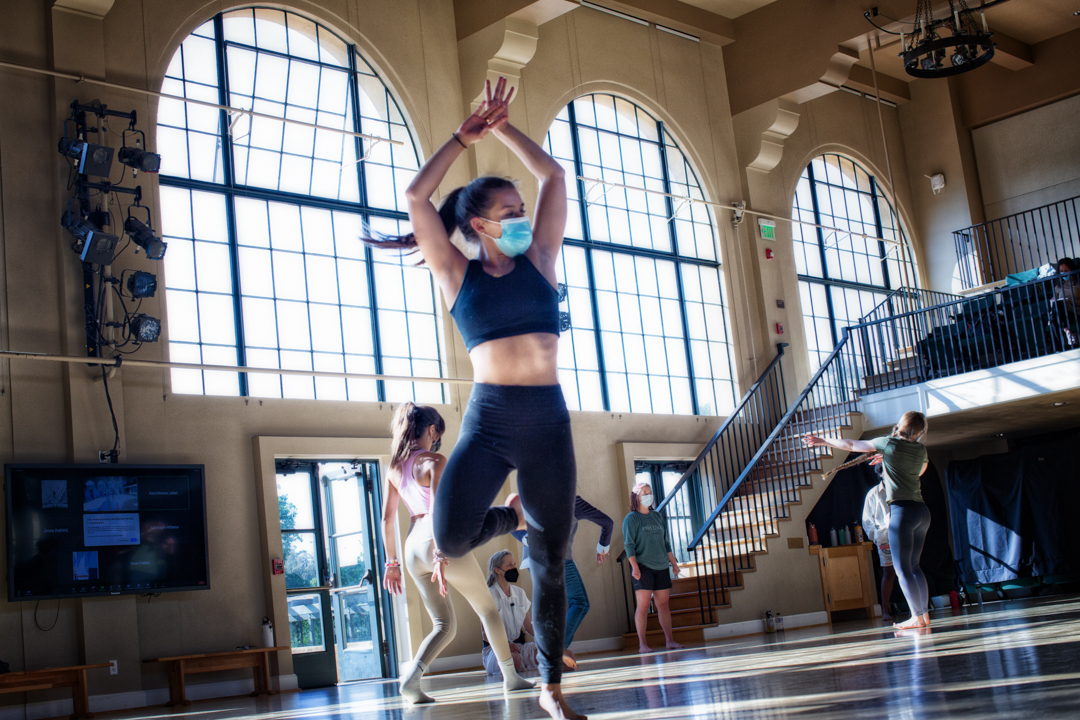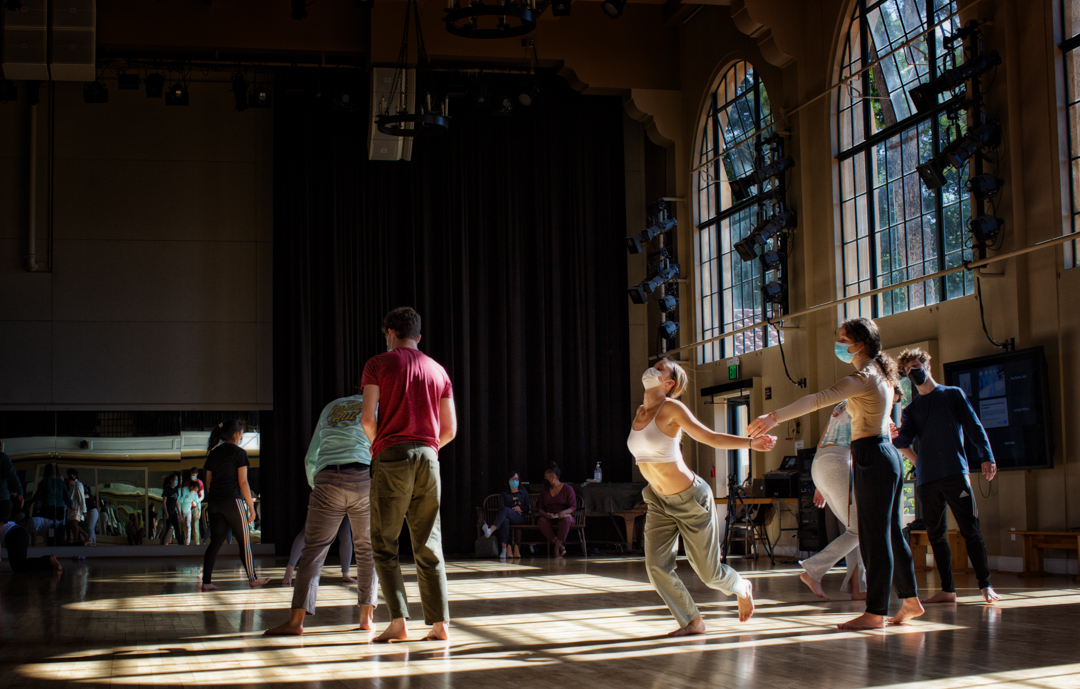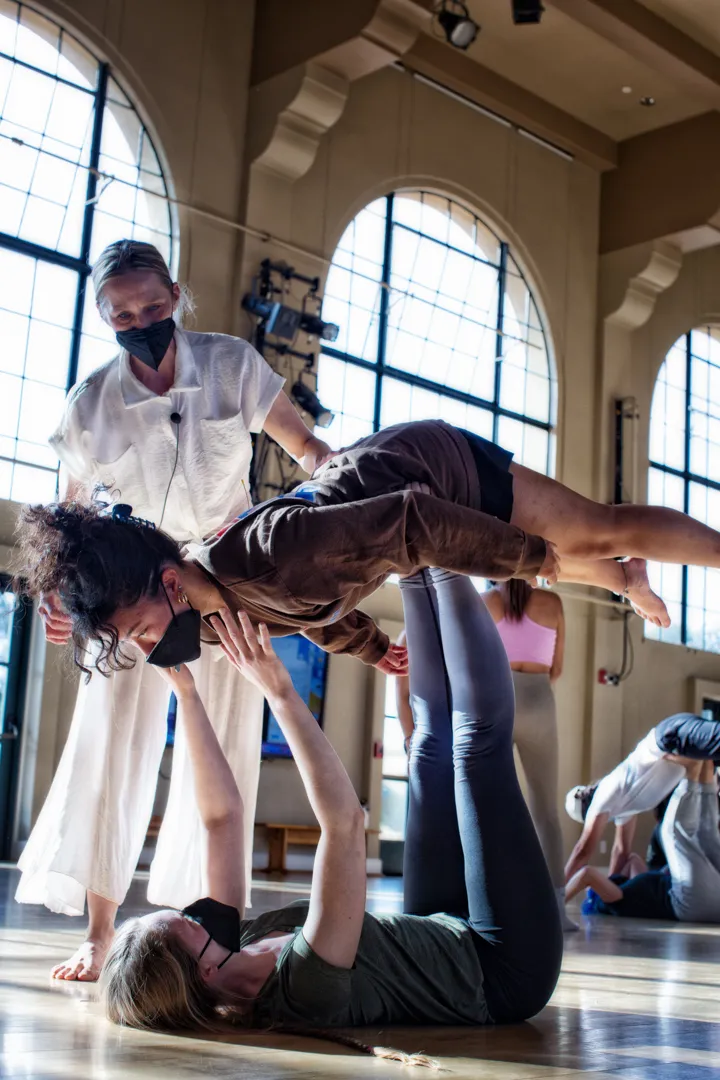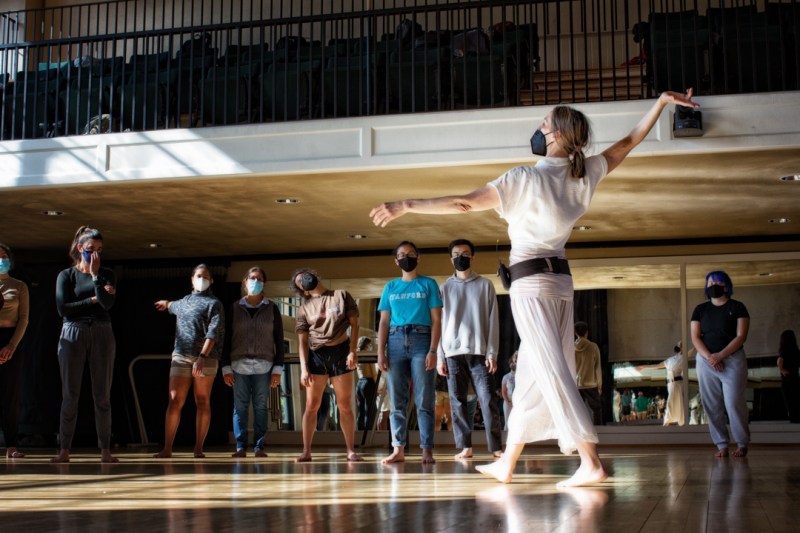A breeze wafts into Roble 113 through an open door; the sun reaches in long rays from its position low in the late afternoon sky. This lofty, expansive atmosphere is only fitting for the one or two dozen dancers that roam the studio’s solid wooden floors. It almost looks like a wide blank canvas, ripe with possibility and inviting their expression.
Each participant wields a unique physicality as the group moves along to a pulsing instrumental track: one person moves in bursts of rapid spins that pick up and slow down at random, crossing the floor in an irregular path. Another hugs the air in a gathering gesture, then mimes the virtual weight of what they’ve picked up. Still another ambles with calculated intention, then stops to twist their body with rolling fluidity, exuding sensuality.
This is the group’s improvisational response to a prompt by Camille Hanson, guest teacher for a masterclass workshop series called “DANCE IS IN OUR NATURE.” Hanson started by pairing up dancers, instructing each to take turns dancing. One partner started by interpreting the themes of “groundedness” and “fluidity” within their lives. The second partner was instructed to “extract the essence” of the first, emulating their techniques without copying the exact movements.

The workshop series, which took place Monday through Thursday of last week, was coordinated by the Planet Earth Arts project of the Earth Island Institute. TAPS senior lecturer Aleta Hayes hosted Hanson in two of her spring classes — “Dance Improvisation from Freestyle to Hip Hop” (DANCE 45) and “Contemporary Modern: Advanced Comparative Techniques” (DANCE 141S).
Hanson brought a distinctive focus on conservation to her masterclasses. Hanson’s concern with the climate crisis — evident in her 2016 multimedia dance performance “The Sacrifice of Giants,” concerning whales and dolphins in captivity — permeates and informs her practice.
Much of last week’s workshop series explored “environmental motifs on the body.” Hanson first called on students to act like they were walking through a river, or as a salmon swimming upstream: here, they moved with resistance. Then she flipped the prompt, having them emulate the rooted yet malleable nature of a weed swaying in the riverbed. In response, students vacillated between steady and volatile qualities of movement — in one moment, a planting of the feet, and in the next, a sudden spin.
The activity aimed to embody the workshop’s broader framework of “radical otherness,” an idea Hanson says she first encountered in an award-winning book by ecologist and philosopher David Abram. Radical otherness teaches us “to embrace difference and embrace the other: what’s not like us, what doesn’t think like us or talk like us,” she said. Extending to fellow humans and the biosphere beyond, radical otherness provides a framework to integrate ourselves and our environment into one living unit.
This grace “creates a connection to what’s different, and that’s fundamental to diversity and ecology and to recovering a unified living ecosystem,” according to Hanson.
Hanson hoped to use last week’s masterclass series as a movement-based research laboratory to investigate how people embody radical otherness. Each segment was geared toward this objective, be it through partner work or mindfulness practices.

“It’s been really fascinating to see people connect to what’s not like them. It’s really about empathy too, just feeling what other people feel and what other species feel and being in the presence of others,” she said about teaching the workshops.
Hanson also explored the closely related idea of “sacred activism,” which focuses on inward change and ideological reflection as opposed to outward action, such as protest. She described this approach as “based on the belief that an open heart is the greatest service and act that we can do for the world.” This inward-out trajectory aims to inspire change through contagious, deep-rooted passion for social change.
Hayes found that contemporary modern dance techniques lent themselves well to research in Hanson’s masterclass. With this form of dance, “You’re researching different ways of moving and thinking about moving,” the lecturer said. It allows each individual to build a creative voice around technical physical ideas — for instance, the weight behind a movement.
Cultivating an inviting, nonjudgmental environment over the course of the quarter is also vital for such workshops to bear fruit, according to Hayes. As they become part of a community, students are emboldened to venture outside of their comfort zones.
Hanson and Hayes’s workshop was organized by Michael Fried, artistic director of Planet Earth Arts. The project brings a wealth of interdisciplinary guest artists to engage with Stanford students and faculty through similar masterclasses or presentations. Planet Earth Arts has also hosted theater and film festivals and established a creative writing prize since its founding in 2014.
Fried said that a range of Stanford faculty members have praised and collaborated in this work, from marine science professor Stephen Palumbi to TAPS’s own Aleta Hayes.
As for the power of movement, Fried cited trailblazing modern dancer and choreographer Martha Graham: “Dance is the hidden language of the soul, of the body.” The aligned vision of Fried, Hudson and Hayes created a space for vulnerability and curiosity — one that allowed students to wield the visceral mother tongue of dance for restorative biospheric empathy.

